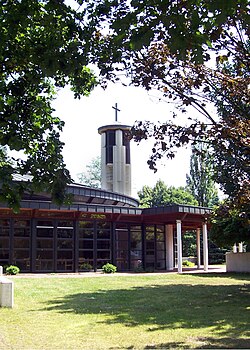Heidberg-Melverode | |
|---|---|
 St. Thomas' Church in Heidberg | |
| Coordinates: 52°13′50″N10°31′56″E / 52.23056°N 10.53222°E | |
| Country | Germany |
| State | Lower Saxony |
| District | urban district |
| City | Braunschweig |
| Government | |
| • Mayor | Hans-Dieter Osswald (SPD) |
| Area | |
• Total | 03.70 km2 (1.43 sq mi) |
| Population (2020-12-31) [1] | |
• Total | 11,419 |
| • Density | 3,090/km2 (7,990/sq mi) |
| Time zone | UTC+01:00 (CET) |
| • Summer (DST) | UTC+02:00 (CEST) |
| Postal codes | 38124 |
| Dialling codes | 0531 |
| Vehicle registration | BS |
Heidberg-Melverode is a Stadtbezirk (borough) in the southern part of Braunschweig, Germany.
Contents
The Stadtbezirk comprises the quarters Heidberg and Melverode.













